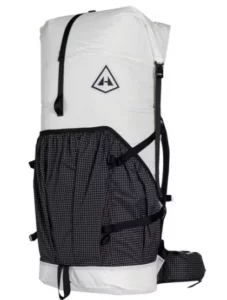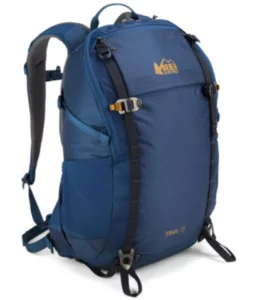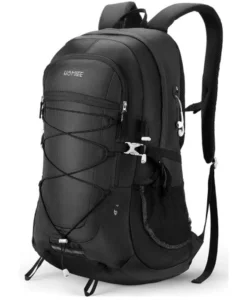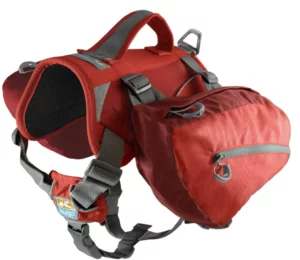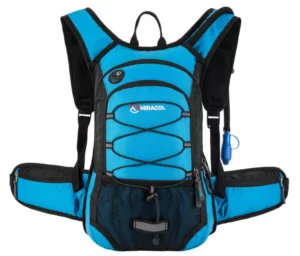
The Best Hiking Backpacks in Canada
It is important to have a hiking backpack when you venture out on the trails. The best backpacks carry all the essentials you need for your hike, like food, water, extra clothing, and first aid material. Whether it be a simple day hike or a multiple night adventure, the hiking backpack is a crucial item to bring along.
If you have started to look for a hiking backpack, you may have noticed all of the shapes and sizes they come in. This can make your task challenging. To help you in your search, we created this buying guide to list the best hiking backpacks in Canada.
Our top picks
Things to look for in a hiking backpack
Fit: The fit of the hiking backpack is one of the most important considerations. A backpack that does not fit you correctly is uncomfortable and restricting. Hiking backpack generally come in three sizes: small, medium, and large. The exact sizing depends on the person’s hip and torso measurements. Knowing these measurements will help you narrow down the correct backpack size for you. Many hiking backpacks have adjustable features that let you customize the pack’s fit.
Weight: Most hiking backpacks are designed to be lightweight. Still, some packs weigh up to four lbs just on their own. To find the right weight for you, consider how much gear you want to carry on your hike. If you are already carrying plenty of gear, then you should stick with a lighter pack.
Carrying capacity: The carrying capacity of a hiking backpack is measured in liters. Lighter backpacks have a carrying volume of 35-44L. Medium sized backpacks can carry 45-60L of gear, while heavy-duty packs carry 65L or more. For this consideration, try to match the backpack’s carrying capacity with the amount of gear you want to bring on your hike. A helpful tip is to lay out the gear you want to bring and see if your hiking backpack can carry all of it.
Padding and support: Since they will be worn for long periods, hiking backpacks come with padding and support features to improve comfort. Most backpacks come with foam padding, which is usually found on the shoulder straps and back panel. Other hiking backpacks have a frame or backplate to distribute the pack’s weight and provide support to your back. According to Switch Pack Travel, it is better to have firm padding rather than soft padding. While it may feel comfortable, soft padding does not provide the long-term support that firm foam does.
Additional features: Every hiking backpack has extra features to improve comfort and improve organization. Here are some common examples:
- Main compartment: This is the main top loading compartment for storing most of your gear. Large items like sleeping bags, clothes, and hiking boots should go here.
- Extra pockets: These are usually on the outside of the backpack. They are perfect for storing small items like keys, Swiss army knifes, snacks, and phones.
- Ventilation: Some hiking backpacks come with a mesh panel on the back panel. The mesh panel promotes airflow and helps eliminate moisture buildup. Backpacks with mesh panels are good for summer hiking and for people who work up a sweat during their hike.
- Water bottle holsters and hydration ports: These two features are come in handy when you need quick access to your water bottle. Holsters are usually on the side of the backpack. Hydration ports store the water bottle inside the backpack and have an opening where you can funnel a drinking tube through. This is a convenient way to take a sip from your water bottle.
- Water resistance: Just like many windbreakers, several hiking backpacks have durable water repellant (DWR) coating on the outer shell. This coating makes water roll off the pack rather than soak through the fabric. For the most part, DWR will keep the inside of your backpack dry. However, it is less effective under heavy downpours.
Best heavy-duty hiking backpack
Hyperlite 4400 Southwest
The Hyperlite 4400 Southwest backpack has plenty of storage space. The backpack can carry up to 70L in gear with an overall load capacity of up to 60lbs. This makes the Hyperlite 4400 a good pack for multiday hikes. This hiking backpack also has multiple external pockets for additional storage. Even though this is a heavy-duty hiking backpack, the Hyperlite 4400 weighs in at 2.45lbs, making it very light. The packs shoulder straps and hip belt work to evenly distribute the weight so that the pack does not wear down on your body.
The Hyperlite 4400 is designed to withstand rugged environments. The backpack has durable abrasion protection to keep your gear safe from the elements. Additionally, the Hyperlite 4400 is water resistant.
Customers were surprised at how light the backpack is despite its size and the amount of gear it can hold. Several people said that the Hyperlite 4400 had tons of storage space and fit comfortably even when carrying heavy loads. However, some people had issues with the pack’s back panel. One person complained that the back panel does not have a frame. This means that some gear can protrude out into your back. Others thought the back panel design limited airflow.
Pros
- Lots of storage space.
- Can hold up to 60lbs in gear.
Cons
- Back panel design limits airflow.
- Back panel has no support frame.
Best small camping backpack
REI Co-op Trail 25
This hiking backpack from REI is light, weighing around 2lbs. Even though it is small, the REI Co-op Trail can hold 25L in gear. It also has side mesh pockets and a zip pocket for additional storage. And if you want even more storage, you can attach an REI Trail 2 Waistpack to this backpack. For comfort and support, the REI Co-op Trail has an internal frame. This helps shield your back from and protruding gear.
People liked this backpack for its comfort and light weight. Several customers found you could store plenty of gear in the REI Co-op Trail, despite its small size. Because of its simplicity, customers recommended this backpack for day hikes. However, some people said that this backpack felt uncomfortable when carrying loads of 15lbs or more. They said that the weight wears down on the shoulders. Other customers wished the backpack had more pouches or pockets. Still, most people agreed that the REI Co-op Trail was a simple, no-frills backpack with plenty of features.
Pros
- Light weight and comfortable.
- Plenty of storage space for a small backpack.
Cons
- Feels uncomfortable when carrying heavy loads, 15 lbs or more.
Best budget hiking backpack
HOMIEE Hiking Backpack
Most hiking backpacks are expensive. For a budget friendly pack, the HOMIEE hiking backpack is a good option. It has a 45L carrying capacity with several storage compartments and pockets. There are also external attachment points for hiking poles or water bottles. In terms of durability, the HOMIEE hiking backpack is made of scratch free nylon fabric. It also has a waterproof coating. For comfort, the pack has an ergonomic design to fit and support your back. The shoulder straps and waistbelt are adjustable to reduce stress and improve comfort. Lastly, the pack has a mesh padding for ventilation.
Many customers said that the HOMIEE hiking backpack had the features of high-end packs but at a lower price. The backpack’s carrying capacity and comfort were all pluses with people. However, this backpack does not have a back plate or frame to protect your back from protruding gear.
Pros
- Lots of features for an affordable price.No back plate or frame.
Cons
- No back plate or frame.
Best hiking backpack for dogs
Kurgo Big Baxter Dog Backpack
If you plan on taking your dog on a hike, then the Kurgo Big Baxter dog backpack is a good option for your furry friend. This backpack carries all of your dog’s essential items like food, treats, toys, water, first aid supplies, and travel bowels. To get the right fit, the backpack has eight adjustable points. The backpack also has an ergonomic padded spine support to evenly distribute weight and provide a comfortable fit. The backpack has a rear mounted leash harness plus a large handle to help your dog over rocks or pull them out of water.
Dog owners found the Kurgo Big Baxter backpack fit their dog well. Many people said that the pack withstood rugged terrain like thick underbrush. The adjustable features were a hit with customers, with several saying it helped balance the load being carried. It is important to correctly size this backpack for your dog. Otherwise, the backpack will be off balance. Sizing the backpack for your dog can take some time, which several people said happened to them. Your dog may also not like wearing the backpack. One approach to this issue is having your dog wear the pack for around 2 weeks before going on the hike. That way, your dog can adjust to wearing the pack. Over time, you can add weight to the pack so your dog can be fully comfortable wearing it.
Pros
- Durable.
- Distributes weight well.
Cons
- Takes time to size the backpack correctly.
- May take some time for your dog to adjust to wearing the backpack.
Our methodology
For this buying guide, we spent up to eight hours compiling our list of hiking backpacks. We only considered backpacks rated four or more stars. To help us evaluate hiking backpacks, our team read many customer reviews. These reviews also helped us learn what people look for in hiking backpacks. We read and referenced articles from trusted websites when we needed more information on hiking backpacks. Lastly, we based our picks on the weight, carrying capacity, size, and comfort of the hiking backpack.
Frequently asked questions about hiking backpacks
Is a hiking backpack worth it?
Hiking backpacks are worth it for their carrying capacity, weight distribution and their overall comfort. They are especially worth the purchase if you plan on doing overnight or multi-day hikes.
What is the best hiking backpack size for a day hike?
Since you do not need as much gear for a day hike, smaller hiking backpacks are good options. They have the right amount of room for your gear without the bulky design of larger, heavier hiking backpacks.
How should I pack a hiking backpack?
The answer to this question depends on how much storage space your hiking backpack has. All your large gear like sleeping bags, jackets, boots, etc. should go in the main storage compartment. If your backpack has additional storage compartments, you can put items like food, water, and first aid supplies there. External pockets can be used to store phones, keys, lighters, knifes, or snacks.
Always try to neatly pack your hiking backpack. Otherwise, your back will feel uncomfortable and unbalanced. Also, you could end up removing everything from the pack just to get one item buried at the bottom.
A good first step is to lay out everything you plan on taking with you. Start to remove things you may not need, then select all of the essential items. This will help you lighten the load you will be carrying.
For an in depth look at packing a hiking backpack, check out this article from MEC.
What is the difference between a backpack and a hiking backpack?
A regular school backpack and a hiking backpack differ in terms of the support they offer. Hiking backpacks provide better support when carrying a large amount of gear. They will evenly distribute the weight between your hips and shoulders, eliminating any strain on your body. If you use a regular backpack to carry tons of gear, your shoulder will bear the brunt of the weight. Eventually, your body will feel the strain of the weight, leaving you sore and fatigued.
The two packs also differ on the amount of storage space they have. Hiking backpacks have many storage compartments and extra pouches, while normal backpacks have limited storage space.
How do I clean a hiking backpack?
Eventually you will need to clean your hiking backpack of the mud, dust, and other stains that have seeped onto the fabric. The cleaning tools you should use include:
- A mild soap, preferably one without fragrances or additives.
- A sponge or washcloth
- A soft bristle brush or a used toothbrush.
Before you begin cleaning, read the manufacturer’s cleaning recommendations for the pack. The recommendations will give you the do’s and don’ts for cleaning your backpack. In general, stick to lukewarm water and lightly scrub your back. Using hot water and scrubbing vigorously can harm your backpack’s protective coating. To get rid of crumbs, dirt, or sand, vacuum the inside of the backpack. If your back allows, submerge it in a bathtub filled with lukewarm water, scrub off the stains, and then rinse the backpack off with cold water.
For a more detailed description on cleaning a hiking backpack, check out this article from REI
Read more

The Best Camping Tents in Canada
Camping is one of the best ways to get into nature, but without the perfect tent – your trip can go downhill fast.

The Best Camping Chairs in Canada
Whether camping, barbecuing, fishing or relaxing in the backyard, do so in comfort with these camp chairs.

The Best Hiking Boots and Trail Shoes in Canada
Boots and shoes are perhaps the most important piece of gear for any hiker.

Hiking Guide: Getting the Most out of Day-hiking and Backpacking
Hiking can be the best way to enjoy the sights and sounds of nature. This guide will help you get started.
